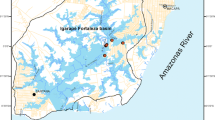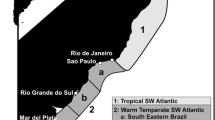Abstract
This paper characterizes the pattern of ectoparasite and endoparasite communities in an assemblage of 35 sympatric fish from different trophic levels in a tributary from the Amazon River system, northern Brazil. In detritivorous, carnivorous, omnivorous and piscivorous hosts, the species richness consisted of 82 ectoparasites and endoparasites, but protozoan ectoparasites such as Ichthyophthirius multifiliis, Piscinoodinium pillulare and Tripartiella sp. were dominant species predominated, such that they were present in 80% of the hosts. The taxon richness was in the following order: Monogenea > Nematoda > Digenea > Crustacea > Protozoa > Acanthocephala = Cestoda > Hirudinea. Among the hosts, the highest number of parasitic associations occurred in Satanoperca jurupari, Aequidens tetramerus, Hoplerythrinus unitaeniatus, Hoplosternum littorale, Cichlasoma amazonarum, Chaetobranchus flavescens, Squaliforma emarginata, Chaetobranchopsis orbicularis and Hoplias malabaricus.A weak positive correlation between ectoparasite abundance and length of the hosts was observed. Ectoparasite communities of detritivorous, carnivorous and omnivorous hosts were similar, but these differed from the communities of piscivorous hosts. Larval endoparasite species with low host specificity were the main determinants of the parasite infracommunity structure of the fish assemblage. Fish assemblage had few species of helminth that were specialist endoparasites, while many were parasites at the larval stage, infecting intermediate and paratenic hosts. Finally, carnivorous and omnivorous hosts harbored endoparasite communities that were more heterogeneous than those of detritivorous and piscivorous hosts. This result lends supports to the notion that the feeding habits of the host species are a significant factor in determining the endoparasites fauna.
Similar content being viewed by others
References
Albert, J.S., Reis R.E. 2011. Introduction to Neotropical freshwaters. In: Albert, J.S., Reis R.E. (Eds). Historical biogeography of Neotropical freshwater fishes. University of California Press, Berkeley, pp. 3–19
Alcântara, N.M., Tavares-Dias, M. 2015. Structure of the parasite communities in two Erythrinidae fish from Amazon River system (Brazil). Brazilian Journal of Veterinary Parasitolog y, 24, 183–190
Beevi, M.R., Radhakrishnan S. 2012. Community ecology of the metazoan parasites of freshwater fishes of Kerala. Journal of Parasitic Diseases, 36, 184–196
Bellay, S., Oliveira, E.F., Almeida-Neto, M., Lima-Junior, D.P., Takemoto R. M., Luque J.L. 2013. Developmental stage of parasites influences the structure of fish-parasite networks. Plos One, 8, e75710. DOI:10.1371/journal.pone.0075710
Bellay, S., Oliveira, E.F., Almeida-Neto, M., Abdallah, V.D., Azevedo R.K., Takemoto R. M., Luque J.L. 2015. The patterns of organization and structure of interactions in a fish-parasite network of a Neotropical river. International Journal for Parasitology, 45, 549–557. DOI: http://dx.DOI.org/ 10.1016/j.ijpara.2015.03.003
Bittencourt, L.S., Pinheiro, D.A., Cárdenas, M.Q., Fernandes, B.M., Tavares-Dias M. 2014a. Parasites of native Cichlidae populations and invasive Oreochromis niloticus (Linnaeus, 1758) in tributary of Amazonas River (Brazil). Brazilian Journal of Veterinary Parasitology, 23, 44–54
Bittencourt, L.S., Silva U.R.L., Silva L.M.A. Tavares-Dias M. 2014 b. Impact of the invasion from Nile tilapia on natives Cichlidae species in tributary of Amazonas River, Brazil. Biota Amazônia, 4, 88–94
Bush, A.O., Lafferty, K.D., Lotz, J.M., Shostak W. 1997. Parasitology meets ecology on its own terms: Margolis et al. Revisited. Journal of Parasitology, 83, 575–583
Choudhury, A., Dick T.A. 2000. Richness and diversity of helminth communities in tropical freshwater fishes: empirical evidence. Journal of Biogeography, 27, 935–956
Dormann, C.F., Fruend, J., Bluethgen, N., Gruber B. 2009. Indices, graphs and null models: analyzing bipartite ecological networks. The Open Ecology Journal, 2, 7–24
Froese, R., Pauly, D., Editors. 2017. Fish Base. World Wide Web electronic publication. www.fishbase.org, version (06/2017)
Garcez R.C.S., Souza, L.A., Frutuoso, M.E., Freitas C.E.C. 2017. Seasonal dynamic of Amazonian small-scale fisheries is dictated by the hydrologic pulse. Boletim do Instituto da Pesca, 43, 207–221
Guégan, J.F., Lambert, A., Lévêdque, C., Combes, C., Euzet L. 1992. Can host body size explain the parasite species richness in tropical freshwater fishes? Oecologia, 90, 197–204. DOI: 10.1007/BF00317176
Grutter A.S. 1994. Spatial and temporal variations of the ectoparasites of seven reef fish species from Lizard Island and Heron Island, Australia. Marine Ecology Progress Series, 115, 21–30
Hammer, O., Harper D.A.T., Ryan P.D. 2001. PAST: paleontological statistics software package for education and data analysis. Palaeontologia Electronica, 4, 1–9
Hoshino M.D.F.G., Neves, L.R., Tavares-Dias M. 2016. Parasite communities of the predatory fish, Acestrorhynchus falcatus and Acestrorhynchus falcirostris, living in sympatry in Brazilian Amazon. Brazilian Journal of Veterinary Parasitology, 25, 207–216. DOI: http://dx.DOI.org/10.1590/ S1984-29612016038
Junk W.J. 2013. Current state of knowledge regarding South America wetlands and their future under global climate change. Aquatic Sciences, 75, 113–131
Lafferty, K.D., Allesina, S., Arim, M., Briggs, C.J., De Leo, G., Dobson A.P., et al. 2008. Parasites in food webs: the ultimate missing links. Ecology Letters, 11, 533–546. DOI: 10.1111/j.1461-0248.2008.01174.x
Kennedy C.R. 1990. Helminth communities in freshwater fish: structured communities or stochastic assemblages? In: Esch, G.W., Busch A.O, Aho J.M. (Eds) Parasite communities: patterns and processes. Chapman and Hall, pp. 131–156
Krebs C.J. 1999. Ecological methodology. Addison-Wesley Educational Publishers, pp. 581
Kuris, A.M., Blaustein, A.R., Alió J.J. 1980. Hosts as islands. American Naturalist, 116, 570–586
Luque, J.L., Poulin R. 2007. Metazoan parasite species richness in Neotropical fishes: hotspots and the geography of biodiversity. Parasitology, 134, 865–878.
Luque, J.L., Poulin R. 2008. Linking ecology with parasite diversity in Neotropical fishes. Journal of Fish Biology, 72, 189–204. DOI:10.1111/j.1095-8649.2007.01695.x
Marcogliese D.J. 2002. Food webs and the transmission of parasites to marine fish. Parasitology, 124, 83–99
Marcogliese, D.J., Cone D.K. 1997. Food webs: a plea for parasites. Trends in Ecology & Evolution, 12, 320–325
Oksanen, J.F., Blanchet, G., Friendly, M., Kindt, R., Legendre, P., McGlinn, D., Minchin, P.R., O’Hara R. B., Simpson, G.L., Solymos, P., Stevens M.H.H., Szoecs, E., and Wagner H. 2017. Vegan: Community Ecology Package. R Package version 2.4–3. https://CRAN.R-project.org /package=vegan
Pérez-Ponce de León, Choudhury A. 2005. Biogeography of helminth parasites of freshwater fishes in Mexico: the search for patterns and processes. Journal of Biogeography, 32, 645–659
Poulin R. 2001. Another look at the richness of helminth communities in tropical freshwater fishes. Journal of Biogeography, 28, 737–743
Poulin R. 2004a. Macroecological patterns of species richness in parasite assemblages. Basic Applied Ecology, 5, 423–434
Poulin R. 2004b. Parasite species richness in New Zealand fishes: a grossly underestimated component of biodiversity? Diversity and Distributions, 10, 31–37
Poulin, R., Leung T.L.F. 2011. Body size, trophic level, and the use of fish as transmission routes by parasites. Oecologia, 166, 731–738. DOI 10.1007/s00442-011-1906-3
R Core Team. 2017. R: A language and environment for statistical computing. R Foundation for Statistical Computing, Vienna, Austria. URL https://www.R-project.org.
Ruehle, B.P., Herrmann, K.K., Higgins, C.L. 2017. Helminth parasite assemblages in two cyprinids with different life history strategies. Aquatic Ecology, 51, 247–256
Valtonen, E.T., Marcogliese, D.J., Julkunen M. 2010. Vertebrate diets derived from trophically transmitted fish parasites in the Bothnian Bay. Oecologia, 162, 139–152
Salgado-Maldonado, G., Novelo-Turcotte, M.T., Caspeta-Mandujano J.M., Vazquez-Hurtado, G., Quiroz-Martínez, B., Mercado-Silva, N., Favila M. 2016. Host specificity and the structure of helminth parasite communities of fishes in a Neotropical river in Mexico. Parasite, 23, 61. DOI: 10.1051/parasite/2016073
Silva, A.Q., Takiyama, L.R., Costa-Neto, S.V., Silveira O.F.M. 2009. Valoração ambiental das unidades fitoecológicas remanescentes da bacia hidrográfica do Igarapé Fortaleza. OLAM–Ciência & Tecnologia, 9, 354–384
Takiyama, L.R., Silva, A.Q., Costa W.J.P., Nascimento H.S. 2004. Qualidade das águas das ressacas das bacias do Igarapé da Fortaleza e do Rio Curiaú. In: (Eds. Takiyama, L.R., Silva A.Q). Diagnostico das ressacas do Estado do Amapá: bacias do Igarapé da Fortaleza e Rio Curiaú, Macapá-AP. CPAQ/IEPA e DGEO/SEMA, Macapá, pp. 81–104. (In Portuguese)
Takiyama, L.R., (et al.). 2012. Projeto zoneamento ecológico econômico urbano das áreas de ressacas de Macapá e Santana, estado do Amapá: relatório técnico final. Luis Roberto Takiyama. Macapá: IEPA, pp. 84 (In Portuguese)
Tavares-Dias, M., Oliveira M.S.B., Gonçalves, R.A., Silva L.M.A. 2014. Ecology and seasonal variation of parasites in wild Aequidens tetramerus, a Cichlidae from the Amazon. Acta Parasitologica, 59, 158–164. DOI: 10.2478/s11686-014-0225-3
Tavares-Dias, M., Gonçalves, R.A., Oliveira M.S.B., Neves L.R. 2017. Ecological aspects of the parasites in Cichlasoma bimaculatum (Cichlidae), ornamental fish from the Brazilian Amazon. Acta Biológica Colombiana, 22, 175–180. DOI: http://dx.DOI.org/10.15446/abc.v22n2.60015
Thomaz, D.O., Costa Neto, S.V., Tostes L.C.L. 2004. Inventario florístico das ressacas das bacias do Igarapé da Fortaleza e do Rio Curiaú. In: (Eds. Takiyama, L.R., Silva A.Q). Diagnostico das ressacas do Estado do Amapá: bacias do Igarapé da Fortaleza e Rio Curiaú, Macapá-AP. CPAQ/IEPA e DGEO/SEMA, Macapá, pp. 1–22 (In Portuguese)
Timi, J.T., Rossin, M.A., Alarcos, A.J., Braicovich, P.E., Cantatore D.M.P., Lanfranchi A.L. 2011. Fish trophic level and the +similarity of non-specific larval parasite assemblages. International Journal for Parasitology, 41, 309–316. DOI: 10.1016/j.ijpara.2010.10.002
Walker JG, Hurford A, Cable J, Ellison AR, Price SJ, Cressler, CE. 2017. Host allometry influences the evolution of parasite host-generalism: theory and meta-analysis. Philosophical Transactions of the Royal Society B, 372, 20160089. http://dx.DOI.org/10.1098/rstb.2016.0089
Zar J.H. 2010. Biostatistical analysis. 5th ed. Prentice Hall, New Jersey, pp. 944
Author information
Authors and Affiliations
Corresponding author
Rights and permissions
About this article
Cite this article
Baia, R.R.J., Florentino, A.C., Silva, L.M.A. et al. Patterns of the parasite communities in a fish assemblage of a river in the Brazilian Amazon region. Acta Parasit. 63, 304–316 (2018). https://doi.org/10.1515/ap-2018-0035
Received:
Revised:
Accepted:
Published:
Issue Date:
DOI: https://doi.org/10.1515/ap-2018-0035




